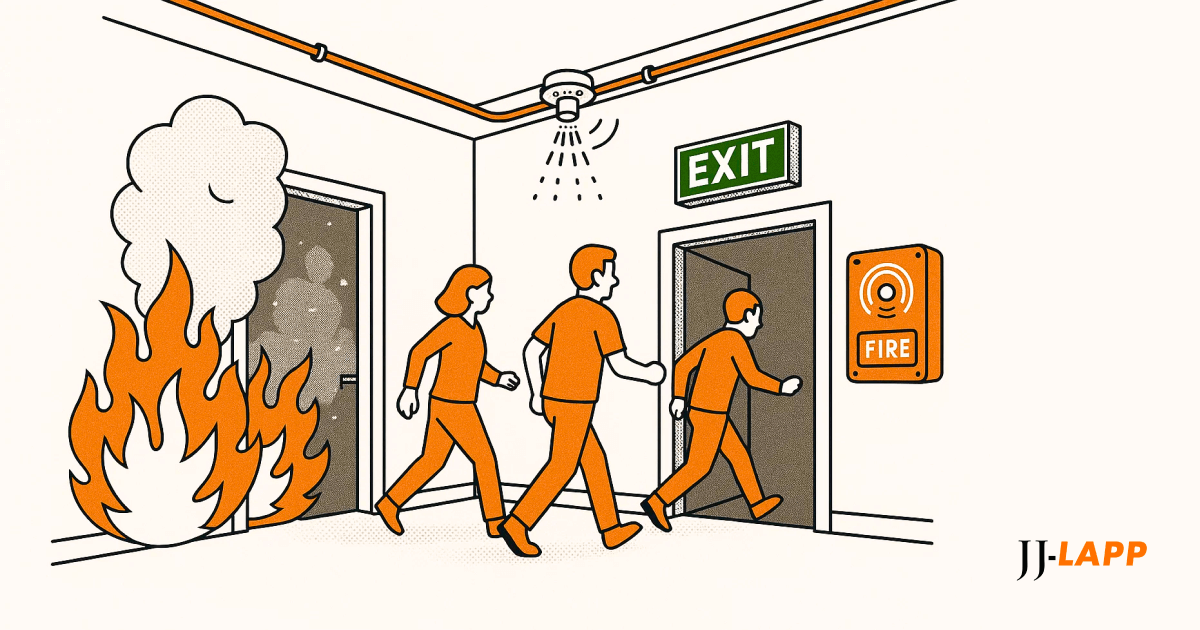Every building manager’s nightmare is a fire—not just for the flames, but for the silent killer: smoke. In fact, toxic smoke causes 50–80% of fire-related fatalities, obscuring visibility, choking airways, and making escape nearly impossible. For building managers, engineers, and system integrators, understanding how fire-resistant cables keep these dangers in check isn’t just prudent—it’s a lifesaver.
Let’s clarify exactly why fire-resistant cables matter, how they function in real emergencies, and how selecting the right cables can protect both occupants and property while meeting crucial building codes across Southeast Asia.
Understanding Fire-Resistant Cables
Why Ordinary Cables Fail
Most standard electrical cables are made from polyvinyl chloride (PVC). While affordable, PVC releases dense, toxic smoke loaded with halogens when exposed to fire. Halogen gases impair breathing and quickly fill rooms, severely hindering evacuation and emergency response. Within minutes, ordinary PVC cables melt and short-circuit, crippling alarms, emergency lighting, and critical systems exactly when they’re needed most.
Quick Comparison: Ordinary vs. Fire‑Resistant Cables
| Feature | Ordinary PVC Cables | Fire‑Resistant / LSZH Cables |
| Smoke output | Dense, toxic, reduces visibility | Low smoke, minimal toxicity |
| Halogen content | Yes – releases corrosive gases | Zero halogen |
| Circuit integrity in fire | Fails within minutes | Survives 30–90 min (IEC 60331 / BS 6387) |
| Compliance with life‑safety codes | Often fails modern codes | Meets SG Fire Code 2023, BOMBA MS IEC 60331, etc. |
| Up‑front cost | Lower | ≈ 20–30 % higher |
| Total cost of ownership | High – downtime, repairs, liability | Lower – prevents shutdowns and legal penalties |
What Makes a Cable Fire-Resistant?
Unlike regular cables, fire-resistant cables have specialized constructions featuring insulating layers like mica tape and ceramic barriers. Imagine wrapping your wiring in a fireproof ceramic shield—these layers can withstand extreme temperatures (750–950°C) for up to 90 minutes (standards IEC 60331, BS 6387). Crucially, this means alarms keep ringing, lights stay lit, and critical communications remain operational, buying precious minutes during an evacuation.
How Fire-Resistant Cables Protect People & Property
Maintaining Critical Systems
During fires, maintaining circuit integrity is vital. For instance, a data center’s emergency generator cables must survive initial blaze conditions to avoid catastrophic downtime. Consider a warehouse scenario: fire-resistant cables kept an emergency generator online, preserving fire pumps and sprinklers.
Real‑world example: JJ‑LAPP has supplied ÖLFLEX® FR‑6387 cables to several high‑rise residential projects across Southeast Asia—keeping alarms, pumps, and emergency lighting operational for up to 90 minutes during a blaze. Source: Project highlights
Reduced Toxic Smoke with LSZH
Low-Smoke Zero-Halogen (LSZH) jackets are a key part of modern fire-resistant cables. These materials eliminate harmful gases, dramatically reducing smoke density. Think of LSZH as a smoke-eating mask for your wiring, allowing safer evacuation routes with clear visibility and breathable air—directly protecting human life.
Which Fire-Resistant Solutions Are Right for You?
Choosing the right fire-resistant cable depends on your building type, occupancy, and local regulations. Here’s a simplified guide:
| Rating | Temp & Duration | Best for | Example from JJ-LAPP |
| E30 | 30 min @ 750–950°C | Small commercial, offices | ÖLFLEX® FR-6387 2 x 1.5 mm² |
| E60 | 60 min @ 950°C | Medium-sized buildings, hotels | ÖLFLEX® FR-6387 3 x 2.5 mm² |
| E90 | 90 min @ 950°C | Hospitals, data centers, high-rise residential | ÖLFLEX® FR-6387 Multi-core cables |
For unusual building layouts or legacy buildings needing customized solutions, consider exploring JJ-LAPP’s customised cables.
Practical Steps to Implement Fire-Resistant Cables
- Assess Local Building Codes
Regulations differ across Southeast Asia:- Singapore’s Fire Code 2023 mandates BS 6387 CWZ compliance.
- Malaysia’s BOMBA regulations require MS IEC 60331 & 60332 standards.
- Indonesia, Thailand, and Vietnam often follow IEC standards but with specific local city amendments.
- Singapore’s Fire Code 2023 mandates BS 6387 CWZ compliance.
- Ensure Proper Certification
Always verify cable certifications (e.g., TÜV-PSB, UL). Legitimate, third-party testing is critical for insurance and compliance. - Coordinate Installation
Clearly brief your installation team. Correct cable routing, labeling, and conduit selection will enhance fire performance. JJ-LAPP offers resources to ensure best practices. - Regular Maintenance & Inspections
Conduct annual inspections and testing. Early detection of wear ensures reliability during emergencies.
FAQs: Common Questions & Concerns
Are fire-resistant cables always necessary?
Yes, especially for circuits critical to safety like emergency lighting, fire alarms, smoke extraction fans, and emergency generators. Local codes typically mandate their use for high-risk areas.
Do they cost significantly more?
Initially, yes—20–30% higher. However, consider the cost of a single major fire incident. Industrial sites alone faced US$1.5 billion in losses last year. The slight premium for fire-resistant cables delivers tremendous ROI by preventing catastrophic downtime and potential loss of life.
Can they be installed in older buildings?
Absolutely. Retrofitting older buildings is both feasible and advisable. Partial upgrades focusing on critical circuits significantly boost safety and compliance.
Conclusion
Fire-resistant cables are not just technical requirements—they are essential to safeguarding human lives and protecting your valuable assets. With a strategic selection, informed installation, and regular maintenance, the benefits vastly outweigh initial costs.
At JJ-LAPP, we provide trusted, certified fire-resistant solutions designed specifically for Southeast Asia’s diverse requirements. Whether you’re upgrading a single building or developing a large complex, our specialists are ready to assist.Get in touch via our inquiry page or explore fire‑resistant options on our eShop to keep your building prepared—protecting occupants, assets, and your reputation.
